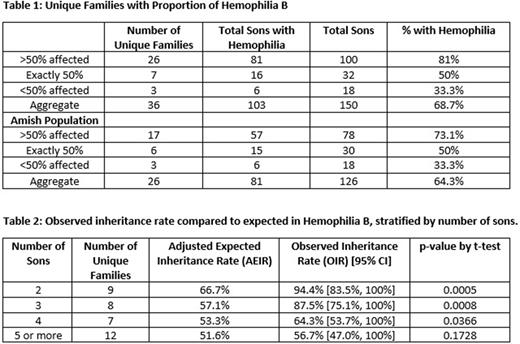Abstract
BACKGROUND Hemophilia A and B are X-linked recessive disorders. Each male offspring born of parents with carrier female and an unaffected male have a 50% chance of being affected with hemophilia. We have observed a higher prevalence of affected hemophilia A and B males in our patient families, than expected of classical X-linked inheritance. We investigate the observed inheritance rate (OIR) of hemophilia A and B in males at our institution to determine whether the disease is preferentially inherited compared to the expected rate of inheritance.
METHODS All patients with diagnosis of either hemophilia A (89) or B (166) at our institution as of 3/1/2022 were included in the initial pool of patients. Patients ages 18 or younger were excluded. The electronic records were reviewed for family history (FH) of hemophilia, focusing on male inheritance and maternal carrier status. Families with only one son were excluded to reduce selection bias from families with only one son and who had not inherited the mutation. Siblings were identified by chart review and were excluded to avoid duplication. Patients were formed into unique families (UFs) if carrier status of the mother could be reasonably inferred by either 1) presence of two or more children with hemophilia or 2) documentation of the mother's factor deficiency or mutation status or FH of carrier status. Statistical analysis for male inheritance was conducted in two ways. First, UFs were stratified by total number of sons. An adjusted expected inheritance rate (AEIR) was calculated, adjusting for carrier mothers who have no affected sons and thus would be missed by our selection process. This was compared to the OIR with a one-sample t-test. If the sample was too small, UFs were aggregated and compared using the highest AEIR. Second, the total number of brothers of affected patients were aggregated. The OIR of the brothers of affected patients was compared to the 50% expected inheritance rate of classical X-linked inheritance by z-test. Female inheritance was not investigated as carrier status could not be reliably obtained.
RESULTS Thirty-six UFs with hemophilia B were identified. 26/36 had >50% of sons affected. The total aggregate prevalence was 103/150 (68.7%). There were 9 UFs with 2 total sons with a mean OIR of 94.4% compared to the 66.7% AEIR (p=0.001, 95% CI LL 83.5%). There were 8 UFs with 3 total sons with a mean OIR of 87.5% compared to the 57.1% AEIR (p=0.001, 95% CI LL 75.1%). There were 7 UFs with 4 total sons with a mean OIR of 64.3% compared to the 53.3% AEIR (p=0.037, 95% CI LL 53.7%). There were 12 UFs with 5 or more sons with a mean OIR of 56.7% compared to the aggregated 51.6% AEIR (p=0.173). There were 115 total brothers of hemophiliacs, 69 of which had hemophilia. The OIR was 60% for brothers (p=0.0147, 95% CI LL 52.4%). 26/36 UFs were of Amish decent, comprising an aggregate prevalence of 81/126 (64.3%).
Nine UFs with hemophilia A were identified. 6/9 UFs had >50% of sons affected. The total aggregate prevalence was 16/22 (72.7%). As the sample was small, all 9 UFs were compared to the aggregated AEIR of 66.7%. The mean OIR was 77.8% (p=0.131, 95% CI LL 59.6%). There were 13 brothers of hemophiliacs, 7 of which had hemophilia. The OIR was 53.8% for brothers (p=0.395).
CONCLUSION Our data suggests that there is a higher proportion of affected males with hemophilia B than expected from the classical X-linked inheritance pattern. There were no significant differences in our hemophilia A group compared to expected rates of inheritance, though this was limited by our small sample size. We plan to analyze the specific genetic mutations of our patients to further elucidate any links to potential preferential inheritance. A larger dataset is needed to confirm our findings.
Disclosures
Ahuja:Sanofi: Membership on an entity's Board of Directors or advisory committees, Speakers Bureau; CSL Behring: Membership on an entity's Board of Directors or advisory committees, Speakers Bureau; Genentech: Membership on an entity's Board of Directors or advisory committees; ClotChip: Patents & Royalties; TraumaChek: Patents & Royalties; State of Ohio Rare Disease Advisory Council: Membership on an entity's Board of Directors or advisory committees.
Author notes
Asterisk with author names denotes non-ASH members.


This feature is available to Subscribers Only
Sign In or Create an Account Close Modal